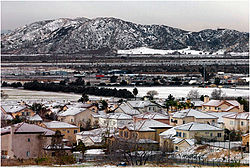San Bernardino Valley
[3] The San Bernardino Valley was originally inhabited by Californian Native Americans, including the Serrano, Cahuilla, and Tongva tribes.
The Spanish missionaries established the Politana rancheria in the valley in 1810, an estancia, or ranch outpost, of Mission San Gabriel Arcángel.
Don Lorenzo Trujillo brought the first colony of settlers from New Mexico to settle on land provided by the Lugos about one half mile south of the Indian village of La Politana.
The San Bernardino Valley owes its existence to the convergence of several mountain ranges that feed into the Santa Ana River basin.
Joan Didion, in her essay "Some Dreamers of the Golden Dream," describes the San Bernardino Valley as "...in certain ways an alien place: not the coastal California of the subtropical twilights and the soft westerlies of the Pacific but a harsher California, haunted by the Mojave just beyond the mountains, devastated by the hot dry Santa Ana wind that comes down through the passes at 100 miles an hour and works on the nerves.
Sage scrub and the Yucca plant are the predominant natural vegetation along washes and uplands; it intergrades with chaparral at elevations of 600 to 700 meters.
Other vegetation consists of a patchwork of grasslands, riparian woodlands, and mixed hardwood forests, which border the valley in the mountains on the north and east.
At times, the seasonal Santa Ana winds are felt particularly strongly in the San Bernardino area as warm and dry air is channeled through nearby Cajon Pass during the autumn months.
This phenomenon markedly increases the wildfire danger in the foothill, canyon, and mountain communities, which the cycle of cold, wet winters and dry summers helps create.
The Route 66 Rendezvous in downtown San Bernardino attracts about half a million people annually from all over the world to watch California's largest classical car show.
[16] Despite a significant number of the cities and towns being "bedroom communities" with residents commuting to nearby Los Angeles or Orange counties for work, the San Bernardino Valley is an important transportation center to the state and country.
Located approximately 70 miles east of the Ports of Los Angeles and Long Beach, a high percentage of goods destined for the rest of the country as well as items on their way out to the world pass through the valley, most of it on trains or trucks.
The Greater San Bernardino Area, along with the rest of the Inland Empire, is ranked by Forbes magazine as one of the American's unhealthiest commutes.
The largest bus agency in the Greater San Bernardino area is Omnitrans, which covers virtually the entire valley.




